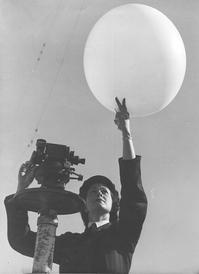


RAAF Meteorological Service
Foreword
Introduction
Chapter 1: The Weather Factor in Warfare
Chapter 2: Establishing and Developing the RAAF Directorate of Met. Services (D.Met.S)
Chapter 3: Recruiting and Training of Personnel
Senior Officers
Recruitment and Personnel
The WAAAF
Training Courses
'Who are these Met blokes?'
Chapter 4: Meteorology in Aviation
Chapter 5: The Met. Retreating
Chapter 6: The Met. Advancing
Chapter 7: The Met With the Army and the Navy
Chapter 8: Divisional Offices of the Bureau of Meteorology During the War
Chapter 9: Research and Instrumental Development
Chapter 10: The End, Aftermath, and Beyond
Appendix 1
Appendix 2
Appendix 3
Appendix 4
References
Index
Search
Help
Contact us

The WAAAF (continued)
Mrs Dorothy Wilkinson (nee Ross) wrote about her experiences as a Meteorological Assistant at the Melbourne bureau during 1942 and 1943.'In the mapping office upstairs at the met. bureau were nine or ten girls who plotted the maps as the reports came in from all over Australia. Then the maps were passed to the officers in an adjoining office to fill in the isobars, and from there the reports were sent out around Australia. There were three officers—Flight-Lieutenant P. Squires, Pilot Officer Max Cassidy and Pilot Officer Henry Phillpot.''The girls were Sergeants Roma Thomas (who did an officer's course), Ivy Burden, Gwen Dixon, Irene Britton (whose husband was killed in action in 1942); Corporals Edna Camp and Dulcie Ross (me); ACWs Enid Egan and Val Mercier; and a civilian, Dorothy Moore.'
'We did shift work around the clock. Most of the girls lived at home, but the girls from the country lived in hostels. Some of us lived in 'Heathfield', a beautiful mansion in Kooyong Road, Toorak, which belonged to Sir Keith and Lady Murdoch. They loaned it for the duration as a hostel for service women. We used to catch all-night trams at all hours—a thing one would be afraid to do today.'
'One of our main worries at the Bureau at night were the rats. They used to frighten us running around when all was quiet in the early hours of the morning. Periodically, a man was hired to bring his little white rat catcher dogs in to eradicate them.'
Working at Head Office was very fulfilling, but most of us were there for only twelve months, and then posted to a station somewhere.'
'. . . the roof of the bureau was a popular venue for an occasional break during working hours.'[23]
The WAAAF were indeed the women behind the men of the Met. service, holding the fort at home, and so enabling men to be released for essential duty in combat areas.

People in Bright Sparcs - Phillpot, Henry Robert; Squires, Patrick
 |
Bureau of Meteorology |  |
© Online Edition Australian Science and Technology Heritage Centre and Bureau of Meteorology 2001
Published by Australian Science and Technology Heritage Centre, using the Web Academic Resource Publisher
http://www.austehc.unimelb.edu.au/fam/0238.html